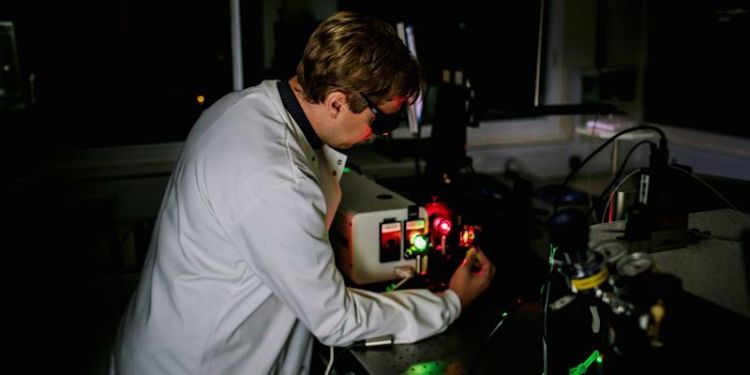Robotics could provide new ways of treating cancer

Robotic technology, nanoparticles and high-intensity ultrasound can be combined with laser illumination to identify then treat cancer without the side effects related to chemo and radiation therapies.
Dr James McLaughlan, who is joint University Academic Fellow between the faculties of Engineering and Medicine and Health, is leading the study. Dr McLaughlan has received an EPSRC-UKRI Innovation Fellowship for his research.
Current treatments of head and neck cancer can have debilitating long-term side-effects, according to Dr McLaughlan. For example, the procedures can harm the patient’s vocal cords, resulting in permanent damage. Existing approaches to treatment require large multidisciplinary teams of medical professionals and several invasive procedures.
Dr McLaughlan talks about his research:
“Our study sets out to develop a new prototype treatment system that could improve diagnosis and therapy of head and neck cancers, while also significantly lowering costs within the NHS by reducing the need for highly trained surgical teams.
“It works by uniquely combining nanoparticles that are targeted to cancer cells with laser illumination and ultrasound, and a waterproof robotic system that has been developed in conjunction with the UK-based robotics manufacturer, ST Robotics.
“It is possible to manufacture nanoscale metallic particles that attach to cancerous cells. Once they have attached, the treatment system is able to activate the particles by exposing them to simultaneous ultrasound and laser illumination, which causes bubbles to form around the nanoparticles. When the bubbles burst, they emit a clear ultrasound signal that can be detected using a standard ultrasound imaging system.”

Dr James McLaughlan using laser illumination to manipulate nanoparticles that are targeted at cancer cells
This approach offers real-time visualisation of the cancerous areas, which can then be immediately treated by thermal ablation, a procedure that involves using heat to remove tissue. High intensity focused ultrasound (HIFU), a method already in clinical use for treating cancers such as liver and prostate, is used to achieve thermal ablation during the procedure described by Dr McLaughlan. He said:
“When the bubbles pop, I can detect where they are. This allows me to pinpoint the cancer sites very accurately. Then, using the same system, I’m able to destroy the cancer (essentially cooking it with thermal ablation) using HIFU, which is enhanced by the presence of those bubbles.
“The third key to this approach is incorporating with a robotic system. This allows automation of this scanning and ablation.
“The waterproof robotic arm will enable semi-autonomous treatment of head and neck cancer. This apparatus, attached to the robot arm, is submerged in a water tank to allow patients to comfortably lie on a treatment bed with a small opening to allow for contact with the water. Having the system submerged in the water allows the imaging/therapy system to move around the area of interest in the patient without any direct physical contact.”
The Fellowship, entitled ‘Semi-autonomous non-invasive surgery: The ‘outside in’ of molecular-targeted theranostics for cancer’, will enable research that could open new possibilities for the treatment and long-term management of head and neck cancers, by ultimately aiming to apply these methods to clinical practice.
Dr McLaughlan was awarded the EPSRC-UKRI Innovation Fellowship for his research, which was carried out with support from two industrial partners.
His research brings together several technologies across different disciplines, and was conducted as part of a multi-disciplinary team of experts in Engineering, Physics and Medicine.

Dr McLaughlan demonstrating the robotic arm which will enable the semi-autonomous treatment of head and neck cancer
Dr McLaughlan added:
“The ultimate idea is that instead of a complicated procedure requiring lots of medical professionals, it could be done by a single person monitoring the procedure. This would only be possible due to the unique combination of targeted-nanoparticles, light, sound and robotics.
“The UKRI fellowship has a specific focus on innovation, and I have partnered with two commercial partners. One of these is a medical imaging company (iThera Medical) who will help validation of the targeting of the particles using their pre-clinical imaging system (MSOT).
“The second is ST Robotics, a company that have developed a low cost robotic arm that we’ve been testing as part of the work. A key focus of this work is to translate it into eventual clinical use (10-15 years), so there is a strong theme of commercialisation and obtaining regulatory approval.”
Dr Maggie Wilson, Joint Head of Building Leadership at EPSRC, said:
“Dr McLaughan’s fellowship is one of the seventy four awards from our recent EPSRC-UK Research and Innovation Fellowships call. Bringing together a multi-disciplinary team the fellowship proposal bridged two of our identified priority areas, “leading edge healthcare and medicines”, and “robotics and artificial intelligence systems”.
The research... will improve the supply of skilled researchers needed to build on the UK’s existing strengths and translate exciting discoveries and research through to commercial success and long-term benefits for the entire country.
"The research is a good example of how engineering and technology can be utilised to improve healthcare provision, brings together industry and academia and will improve the supply of skilled researchers needed to build on the UK’s existing strengths and translate exciting discoveries and research through to commercial success and long-term benefits for the entire country.”
Further information
The EPSRC-UKRI Innovation Fellowships will nurture future leaders in both industry and the research base and promote greater mobility. They will ensure that a variety of UK industrial sectors have a supply of skilled researchers.
Related articles
Medical Xpress - Testing new cancer treatment which could banish chemotherapy




